
This week, we are dealing with the two following questions:
For this week’s questions, see our full video response below!
The phenomenon you’re referring to is actually called differential quenching. The process works in the following way: when you’re tempering glass, you first heat it normally but then you’re using air balance to quench the top and bottom side on a different way. That means that you’re setting a different set point for the quenching pressure on the top side and on the bottom side. As a result you’ll get a slight bending to the flat glass. About the use cases of this kind of bending, the repeatability of that process is not nearly the same as with a bending and tempering machine. So, going with this process with high profile façade project is not very feasible, but you can do small, slightly bent façade projects even with this process. Perhaps more suitable application with this process is your kitchen oven door where you want your glass always to bend to another direction and never on the other side.
This is actually a very frequent question that comes to us and it’s very common that these high-power tempering lines set such a high requirement for the power that our customer have difficulties in getting that to the site. There are couple of options how we can overcome this challenge. If the gap is small, e.g. if you have 600 kW available and the installed power of the machine is 1000 kW, in that case we would manage to solve the issue only with a loading delay – we just delay the loadings so that the heaters and the blowers do not go on at the same time. If your gap is bigger, e.g. you have 600 kW available and the installed power of the machine is 1200 kW or even more, in that case we have to use also the heater limitations i.e. we limit from the program how many heaters are going on at the same time. This way we keep the average process power lower and you can temper glass with that 600 kW which you have available. But remember that this will always have an effect on the capacity when we do these limitations.
Sign up for Glastory newsletter
We answer your questions about glass processing. Let us know your challenges and we promise to do our best to help you.
Comments are closed.